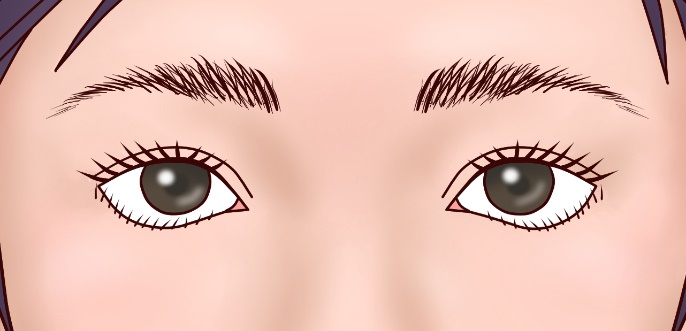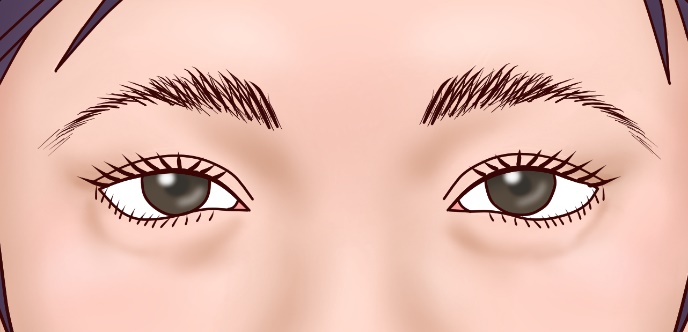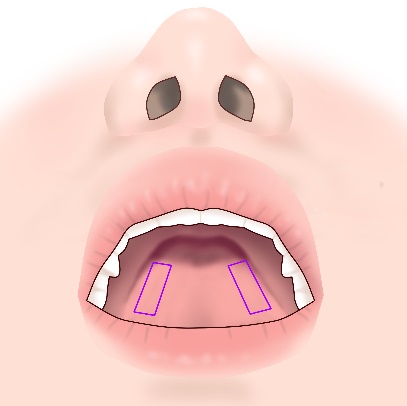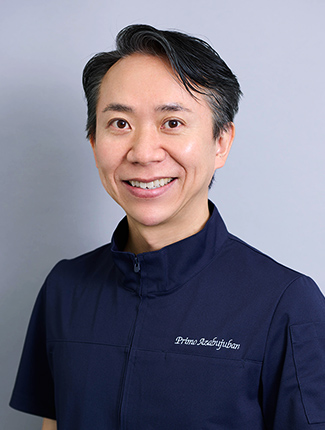To return eyelids that have fallen too low back to their natural shape.
An explanation of widening of the lower eyelid revision surgery.

Widening the lower eyelid revision surgery is a procedure to restore the natural shape of the eyelid after it has been lowered too much.
This is indicated for people who 1) want to restore drooping eyes, 2) want to have natural drooping eyes, 3) are concerned about scleral show, and 4) feel their facial expressions are unnatural.The surgical technique used depends on the case, but in mild cases, simply removing the fixed threads and releasing the adhesion is all that is required to return the eyelid to its natural form.In more severe cases, oral mucosa is transplanted to morph the lower eyelid.
Symptoms


Features of our widening of the lower eyelid revision surgery
- This is a surgery to restore eyelids that have fallen too low back to their natural form.
- Removal of fixation threads, release of scarring and adhesions, replenishment of missing tissue (e.g., transplantation of mucosa), and fixation of the lateral canthus are performed in combination as needed.
- Surgery is performed under intravenous anesthesia, so you won’t feel any pain.
- Skin suturing with transparent thread is also available.
Widening of the lower eyelid revision surgery explained
The scar is corrected through the conjunctival method and the adhesions are released.
If there is a conjunctival insufficiency, the mucosa of the palate is transplanted to adjust the position of the lower eyelid.
Fixation of the lateral canthus to prevent reversion.

When performing widening of the lower eyelid revision surgery, this may result in reversion of the eyelid shape.
Even in such cases, it is still possible to achieve the desired position through a combination of hard palate mucosa grafting and lateral canthus fixation.
We also offer skin suturing with ultra-fine transparent thread.

Duration and aftercare of widening of the lower eyelid revision surgery
《After surgery》
Condition of the affected area
A graft fixation thread is attached to the conjunctival area, and on the skin side, a thread is attached to a small suture on the outside of the double eyelid line.
The artificial dermis is placed over the oral mucosa harvesting site.
There are no threads on the outer skin because the conjunctiva is sutured.
There is a feeling of tightness because of the outward fixation with the buried threads.
Since there is a possibility of slight post-operative reversion, we always account for this in surgery.
Edema may cause the whites of the eyes to temporarily turn jelly-like, but this will disappear over time.
Eye discharge with blood may appear, but this is not abnormal and should be wiped off gently.
Rarely, bruising may occur.Sometimes it appears in the white part of the eye.The bruising will disappear in 1-2 weeks.
Post-operative checkup and aftercare
You will be examined by the doctor just before you go home on the day of surgery.
Antibiotics, painkillers (the pain is usually mild, but we prescribe them just in case), and gastric medicine will be prescribed for 3 days after surgery.
After surgery, we will prescribe two kinds of eye drops and an ointment for dry eyes.
Please apply the eye ointment before going to bed, and use the tape to keep your eyes shut.
Lifestyle advice
You can wash your hair and take a shower on the same day after surgery.
Please refrain from taking a bath or doing any strenuous exercise for about a week.
Makeup can be applied on the same day after surgery except for the eye area.Eye make-up can be applied the day after surgery.
Contact lenses should be avoided for at least 2 weeks until the transplanted tissue has stabilized.However, please refrain from wearing them if you have conjunctival swelling.
Please do not rub the eye area.In rare cases, bleeding or dislodging of the sutures may occur.Also, please rest as much as possible.
Gargle each time after drinking and eating until the oral wounds heal.
Hard foods should also be avoided until healing is complete.
Avoid closing the eyes too tightly and with too much force.
When sleeping, please use cushions to elevate your upper body and head.
Please refrain from drinking alcohol and smoking for about a week.
《Day 7 after surgery》【It is recommended that you visit for a checkup at this time.】
Condition of the affected area
The swelling will go down in a week or two.
There is a possibility of post-operative reversion of the eyelid shape.
Edema may cause the whites of the eyes to temporarily turn jelly-like, but this will disappear over time.
Eye discharge with blood may appear, but this is usual and should be wiped off gently.
Rarely, bruising may occur.Sometimes it appears in the white part of the eye.The bruising will disappear in 1-2 weeks.
Post-operative checkup and aftercare
You will be examined by a doctor.
Lifestyle advice
From the 7th day after the day of surgery, you will be able to bathe and exercise as usual.
Please continue to use eye drops to prevent dry eyes.
Please do not rub the eye area.In rare cases, bleeding or dislodging of the sutures may occur.
Continue gargling after drinking and eating until the oral wound is healed.
《1-3 months after surgery》【It is recommended that you visit for a checkup at this time.】
Condition of the affected area
The wound will gradually heal completely, but there will be some swelling for a while.
Post-operative checkup and aftercare
You will be examined by a doctor.
There is no post-operative procedure.
Lifestyle advice
If dry eyes are a concern, continue to use eye drops.
Contact lenses can be worn.
Please do not rub the eye area.In rare cases, bleeding or dislodging of the sutures may occur.
《6 months after surgery》【It is recommended that you visit for a checkup at this time.】
Condition of the affected area
The wound has almost fully healed.
Post-operative checkup and aftercare
You will be examined by a doctor.
There is no post-operative procedure.
Lifestyle advice
You can resume all of your daily activities.
FAQ
Yes, we will accurately assess your condition and use the appropriate methods.
Please come for a consultation so we can examine your condition.
You should refrain from eating hard foods until the wound is healed, but you can eat soft foods from the same day. You can brush your teeth as usual.
Also, gargle each time after eating or drinking until the wound is healed.
Brushing should be done carefully without hitting the wound.
Pain will be minimal, because our local anesthetic contains extra agents to reduce any discomfort.
To minimize injection pain, the amount of anesthetic used is kept to a minimum of 1-1.5 cc for both eyelids.
Pain is also minimized by using an ultra-fine 34G needle, as well as a new needle for each eyelid.
The local anesthetic is administered very slowly which minimizes pain.
For those who are still afraid of pain, we offer general anesthesia.Under general anesthesia, you will be comfortably unconscious and breathing as usual.
Fees
| Widening of the lower eyelid revision surgery | ¥495,000 |
|---|---|
| Widening of the lower eyelid revision surgery Complex procedures involving tissue transplantation |
¥660,000 |
All fees displayed include tax.
Risks and side effects of widening of the lower eyelid revision surgery
Underneath is a list of things that may occur.
In order to prevent any of these symptoms from occurring, we take safety measures and perform treatment with the utmost care.
We also have a solution for any symptoms should they occur.
We will always improve your symptoms.
Post-operative course
Swelling
Major swelling will go down in 2-4 days after surgery.
Mild swelling may be noticeable for a week or two.
Things will completely settle down in about 6 months.
Bruising around the eye.
It sometimes occurs, but it will disappear in a week or two.
Eyelid discomfort
In the early post-operative period, the eyelids may feel uncomfortable.
When the lateral canthus area is sutured, there is a feeling of tightness.
These symptoms ease over time.
Scars
A small scar forms on the conjunctiva and outside the double eyelid line.
It will become less noticeable over time.
Risks, side effects, and complications
Exposure of buried absorbable sutures
We will remove the stitches.
Infection
Although rare, there is risk of infection with any surgery.
If infection occurs, it may be necessary to treat it with antibiotics or remove any pus by small incisional drainage.
Poor engraftment and necrosis of transplanted tissue
Necrosis may occur, for example, if the transplanted tissue becomes infected.
In such cases, reversion may occur and the surgery results may be inadequate.
Revision surgery may be necessary.
Changes in eyelid morphology
The eyes will be more naturally sized again, and closer to the original facial impression.
The morphology of the tear troughs may also change.
Inverted eyelashes
Inverted eyelashes usually improve as the eyelid approaches its original state.
If they remain after surgery, they can be further improved by inverted eyelash surgery.
Double vision
This can occur when the extraocular muscles are affected by surgery.
Risks at the tissue collection site
Palatal mucosa
It takes 1-2 weeks for the collection site to heal.
Until healing occurs, there may be dull pain, especially with food intake.
Eye surgery list
Detailed information on each eye surgery procedure, including case photos, case progress photos, procedure duration, post-operative course, downtime, aftercare, risks, side effects, and complications.
Supervising Doctor
Under the supervision of our plastic surgeons, we operate our website in accordance with medical advertising guidelines.
NORIHIRO OHBA M.D. Ph.D.
HEAD DIRECTOR/DIRECTOR

Qualifications and Academic Affiliations
Doctor of Medicine
Board Certified Plastic Surgeon, Japan Society of Plastic and Reconstructive Surgery
Board Certified Aesthetic Plastic Surgeon, Japanese Society of Aesthetic Plastic Surgery
Board Certified Aesthetic Plastic Surgeon, Japanese Society of Aesthetic Surgery
Anesthesiologist certified by the Ministry of Health, Labor and Welfare
Member of International Society of Aesthetic Plastic Surgery (ISAPS)
International Member of American Society of Plastic Surgeons (ASPS)
Member of Japan Society of Cranio-Maxillo Facial Surgery
Member of Japan Society of Laser Surgery and Medicine
Career
Graduated from Osaka City University Faculty of Medicine, 1996
Osaka City University Hospital Plastic and Reconstructive Surgery, 1996-1999
Osaka City University Graduate School of Medicine, 1999-2003
Osaka City University Hospital Plastic and Reconstructive Surgery, 2003-2005
Sano Memorial Hospital Plastic and Reconstructive Surgery, 2003-2005
Daito Central Hospital Plastic and Reconstructive Surgery, 2003-2005
Ritz Cosmetic Surgery Tokyo Clinic, 2005-2008
Primo Azabujuban Clinic, 2009~
Head Director, Primo Medical Corporation, 2011~
Head Director/Director, Primo Azabujuban Clinic, 2020~
